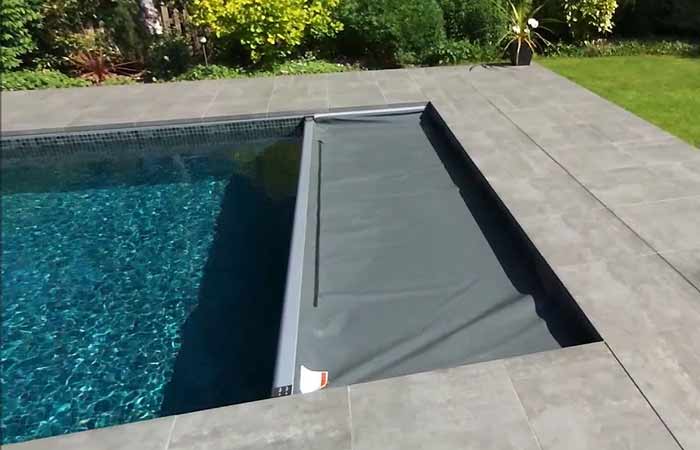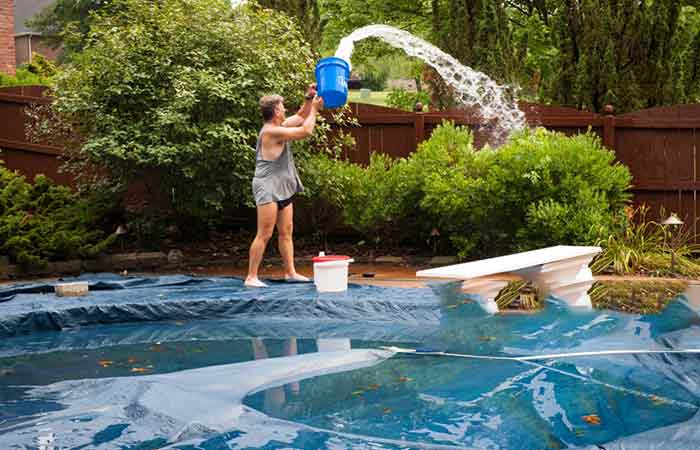How to Keep a Pool Cover from Sagging
Pool covers are designed to keep dirt, leaves and other debris from getting into your pool. Unfortunately, pool covers can sag over time and allow these unwanted objects into the pool while they are in use. This article will cover some of the causes of sagging pool covers and offer suggestions for preventing this situation from happening.
Some of the causes of pool covers sagging include snow on the pool cover, dirt and debris on the pool cover, a low water level, and a poor installation of the pool cover. A torn pool cover can also easily sag when the water seeps to the top of the cover.
You can keep a pool cover from sagging by keeping the center of the cover higher than the edges, securing the edges with heavy objects, adjusting the sagging as soon as you see it, building your own pool cover support structure and many others. It all depends on what causes the pool cover to sag.
Why does my pool cover sag?
Some of the reason as to why your pool cover may sag include the following:

Snow on pool cover
When there’s snow on the pool cover, the pool cover sags. The weight of snow on top of a pool cover causes it to sag.
The type of snow can also cause pool cover sag. For instance, a type of snow called ice crystals will be more difficult to remove than flakes from the sky and this can result in pool covers with sagging issues.
Light snow may not cause pool covers to sag, but heavier snow will. As such, during heavy snowfalls, pool cover sag may be more likely.
If you want to avoid your pool’s cover sagging due to the weight of snow on top of it, try using a net as well as other methods like ice melting agents or de-icing chemicals in order to remove the heavy load that is causing pool covers to be sagging.
The weight of debris and leaves
Just like the issue is with snow, debris and leaves in pool water can cause the sagging of a cover, too. The weighty objects are heavy enough that they pull down on the pool cover which causes it to droop over time when left without intervention.
The debris may also create an area for algae growth since there is less opportunity for light penetration.
You should thus be vigilant when it comes to taking care of pool covers in the fall and winter by checking them every week or so for any issues, such as sagging.
You thus need to check the pool cover weekly for signs of drooping. This can be done visually if you’re able to stand on top of a ladder near enough your pool and look over the whole pool at once. If there is an issue with debris accumulation then remove it promptly before inspecting again.
For safety purposes, never get too close to pool water without protection (i.e., goggles). You should also avoid contact with algae since it may produce harmful bacteria like Legionella which can lead to serious infection if inhaled.
A low water level
A low water level in the pool is one of the most common causes for pool cover sagging. When you open your pool, there is often an adjustment period during which water levels are low at first before they stabilize and reach normal operating conditions again.
If you’ve switched from electric to gas heating or vice versa, this can also affect how quickly water levels return to normal because each type of heating system requires different amounts of energy in order to raise the temperature of the pool’s contents.
A low water level will cause materials like dirt that settle into the empty spaces on top of a pool cover to stick more securely as they dry out due to lack of moisture in those areas.
You can prevent this from happening by periodically checking the water levels on your pool and adjusting as necessary.
If you notice pool cover sagging, remove it immediately so that any potential damage can be repaired before additional harm is caused to the vinyl material or other parts of the pool area.
Poor pool cover installation
When the pool cover is installed improperly, pool covers can sag. This is a result of the weight from snow and ice on top of them when they are not secured properly.
Poor installation or an improper cover design will cause pool covers to droop or sag in spots where there is more weight than others.
Pool covers should be installed with about two inches slack around the perimeter so that they hang down evenly without sagging at any point. Installing the cover too tightly will also likely result in an uneven distribution of pressure which could lead to sagging over time as well. This doesn’t happen all at once but instead occurs with time.
A torn pool cover
If the pool cover is torn, it will not be able to protect the pool from dirt and other debris. Even if you fix a small tear, your cover may start sagging again over time if there are other larger tears that have been ignored.
Torn pool covers need to be repaired as soon as possible in order for them to continue providing protection against bugs and debris.
You should look out for these causes since they help you in keeping the pool cover from sagging.
How to keep a pool cover from sagging
Having known the causes to the sagging of your pool cover, the remedies are as follows:
1. Keep the center of the cover higher than the sides
One way to avoid pool cover sagging is to keep the center of the cover higher than the sides. This will help prevent water from pooling at one side, which can cause it to sag down there and pull up on other corners because of gravity.
The shape adopted is similar to that of the roof of a house.
Keeping the center of the pool cover higher than its edges is not always possible, but if you can do it then it will help to keep your pool clean and safe from damage.
2. Secure the outer edge with heavy objects such as H2O blocks or bags
Another method of pool cover sagging prevention is by securing the outer edge of the pool cover with heavy objects such as H20 blocks or bags. Adding weight to the outer edge of the pool cover will help hold it in place much better.
It also eliminates the sagging thus doing away with any points in the cover where water or dirt may collect.
3. Adjust the sagging on the cover as soon as possible
This one is self-explanatory. Adjust the sagging on the cover as soon as you see it to prevent pool covers from getting too heavy and dragging down in an irreversible way.
4. Use a portable pool cover pump instead
The use of portable pool covers also prevents pool cover sagging. Portable pool covers are easier to keep tight over the pool since they are portable and thus easier to manipulate.
5. Build your own cover support structure
If the above solutions don’t work for you, there’s a less expensive option that will help your cover stay taught: building your own support structure.
A pool cover may sag because the water is too heavy on one end of the pool, or because there isn’t enough weight on each side to keep it in place. Adding an extra pole across the center of the pool can be helpful for this problem if you’re not up for building something from scratch.
You’ll just need some PVC pipe pieces and fittings available at any hardware store to build a frame with two crossbars (one set about 12 inches above ground level, and another at eye-level).
6. Place a pool pillow under the pool cover
Placing a pool pillow under the pool cover will prevent the pool cover from sagging. The pillow should be placed under at least one-third of the pool cover and be cut to size so that it fits tightly against all sides of the pool cover.
Pillows will need to be replaced periodically, as they can lose their shape with time or if exposed to sunlight for prolonged periods.
The primary function of a pool pillow is not only preventing saggy covers but also helping protect your swimming pools liner from UV rays, which causes them to degrade faster than normal due to exposure to the sun.
Pool pillows are available in various colors; choose what best matches your pool’s décor. You can thus choose the one that best spruces up your backyard.
7. Fill the H2O bags 3/4 full
For better securing of the pool cover, fill the H2O bags at least three-quarters full. The pool cover will not sag if there is a decent amount of water in the H20 bags. The water makes the covers heavier hence they will secure the pool covers much better against any weight that may be placed on them.
8. Use a pool safety cover instead
A pool safety cover will prevent sagging in the cover and it will also protect your pool from leaves, debris, insects or other items that can be attracted to water. They are easily installed on top of a regular swimming pool cover with Velcro straps and come with large pockets for storage.
Pool safety covers experience less sagging because there are no air pockets left in the cover.
There is a small chance that pool safety covers can also be punctured, so if you have an above ground or inground swimming pool then it’s best to invest in two of them. They come at a higher cost than regular pool covers but they will last longer and provide more protection for your children and animals as well as prevent any unwanted visitors from enjoying themselves in your pool.
There are many other methods to address pool cover sagging. The most popular method is by using a solar blanket, which makes use of naturally occurring heat from sunlight and does not require any electrical power or fuel sources for operation.
Another preventative measure would be to install an umbrella on your pool cover so that precipitation can run off of it instead of soaking into the plastic material and adding weight and causing saggy covers.
Finally, you could also try laying concrete pavers over your pool’s surface because they have high thermal mass and absorb heat during the day time hours when temperatures rise above ambient levels. This makes them perfect for this type of installation as they take up excess warmth at night releasing that stored energy
In conclusion, keeping a pool cover in place is not difficult or expensive but paying attention to small details can save time and make your life easier. Take care of that pool cover so there will be one less thing for you to worry about during the summer.




